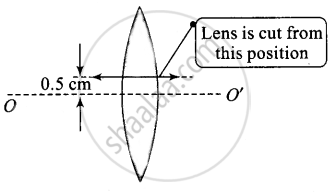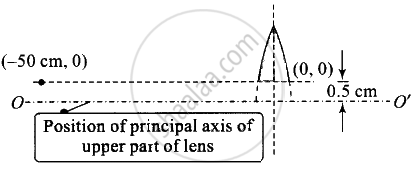Advertisements
Advertisements
Question
A thin convex lens of focal length 25 cm is cut into two pieces 0.5 cm above the principal axis. The top part is placed at (0, 0) and an object placed at (– 50 cm, 0). Find the coordinates of the image.
Solution
If a symmetric lens is cut parallel to principal axis in two parts. The focal length remains the same for each part. The intensity of image formed by each part will be less compared to that of the complete lens.
If there was no cut, then the object would been at a height of 0.5 cm from the principal axis O'.

The top part is placed at (0, 0) and an object is placed at (– 50 cm, 0). There is no effect on the focal length of the lens.

u = – 50 cm, f = 25 cm, v = ?
`1/v - 1/u = 1/f`
`1/v - 1/(-50) = 1/25`
`1/v = 1/25 - 1/50`
= `(2 - 1)/50 = 1/50`
v = 50 cm
`m = (+v)/u = (+(50))/(-50)` = – 1
So the size of image is equal to that of object, m is negative so image is inverted.
So image is at (50 cm), – 1 cm) and 0.5 cm below the X – x' axis.
APPEARS IN
RELATED QUESTIONS
If an object far away from a convex mirror moves towards the mirror, the image also moves. Does it move faster, slower or at the same speed as compared to the object?
Can mirrors give rise to chromatic aberration?
Light is incident from glass (μ = 1.5) to air. Sketch the variation of the angle of deviation δ with the angle of incident i for 0 < i < 90°.
A converging lens and a diverging mirror are placed at a separation of 15 cm. The focal length of the lens is 25 cm and that of the mirror is 40 cm. Where should a point source be placed between the lens and the mirror so that the light, after getting reflected by the mirror and then getting transmitted by the lens, comes out parallel to the principal axis?
According to Cartesian sign convention, all distances are measured from the _______.
According to the mirror equation, ______.
A thin converging lens of focal length 12 cm is kept in contact with a thin diverging lens of focal length 18 cm. Calculate the effective/equivalent focal length of the combination.
The focal length of a convex lens made of glass of refractive index (1.5) is 20 cm.
What will be its new focal length when placed in a medium of refractive index 1.25?
Is focal length positive or negative? What does it signify?
A car is moving with at a constant speed of 60 km h–1 on a straight road. Looking at the rear view mirror, the driver finds that the car following him is at a distance of 100 m and is approaching with a speed of 5 km h–1. In order to keep track of the car in the rear, the driver begins to glance alternatively at the rear and side mirror of his car after every 2 s till the other car overtakes. If the two cars were maintaining their speeds, which of the following statement (s) is/are correct?
An astronomical refractive telescope has an objective of focal length 20 m and an eyepiece of focal length 2 cm.
- The length of the telescope tube is 20.02 m.
- The magnification is 1000.
- The image formed is inverted.
- An objective of a larger aperture will increase the brightness and reduce chromatic aberration of the image.
